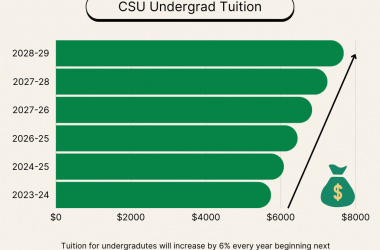A battle is being fought on Atherton Street, where buses, bikes and cars compete for limited space.
Bike lanes along the street, constructed over the summer, brought with them new parking restrictions. The eastbound side of Atherton Street lost about 24 parking spaces near the Walter Pyramid, according to Sumire Gant, transportation programs officer for the city of Long Beach.
Many drivers, unaware of the new signs prohibiting parking, were outraged when they were ticketed for parking on familiar territory. Parking enforcement officers have been patrolling the area since at least early July, often ticketing several cars in a single pass. Some residents have also complained, saying that with the new restrictions on parking, students are moving farther into neighborhoods to avoid the cost of an on-campus permit.
Gant said the city looked at adding parking near the Gerald Daniel Recital Hall in order to make up for the lost spaces. The bike lanes on Atherton Street are part of a larger push to change the city’s image.
“We want to be the most bike-friendly city in the country,” Gant said.
Aside from bike lanes, Long Beach has recently retrofitted several streets with sharrows — markings that indicate a lane is to be shared by cars and cyclists alike. Increasing bicycle access to the Cal State Long Beach campus is one of the goals of the city’s “Bicycle Master Plan,” a lengthy document of recommendations and goals aimed at improving conditions for commuter and recreational riders.
The document’s recommendations for Atherton Street called for reducing the width of normal traffic lanes while adding a 5-foot wide bike lane.
Gant said bike lanes need to be at least 12 feet wide to accommodate both parked cars and cyclists. The double left-turn lanes on the westbound side of Atherton Street made it impossible to create a bike lane of that width on the other side of the street, according to Gant.
Not everyone is upset with the loss of parking. Kevin Flaherty, a founding member of the CSULB Cyclists club, said all parking spaces should have been removed from the street. Flaherty said it was unfair that students who arrived early in the morning could secure free parking while other students had to pay to park on campus.
“It seems to me that this is a little screwed up,” Flaherty said.
Flaherty and others also worry about the “door zone” — the roughly 4-foot area to the left of a parked car where a door opened by a driver can mean disaster for passing cyclists. In order to avoid the door zone, The League of American Bicyclists, a group with about 300,000 members, recommends riding at least 3 feet from a parked car, even if it means riding outside of a bike lane.
Flaherty, a graduate student, resents the mindset many drivers have that bikes don’t belong on the street. He’s quick to point out that California law grants bicycles all the rights and responsibilities of any other vehicle, including the right to ride in normal traffic lanes.
In an effort to better educate cyclists on laws and safety practices, the CSULB Cyclists club and the university’s rideshare program offer a free Traffic Skills 101 class on the third Wednesday of each month. For its part, the city of Long Beach is slated to conduct a “bicycle count” with the help of CSULB and Bikestation on Oct. 15 in many locations throughout the city. For now, it appears the bicycle is here to stay.
Kendra Ablaza contributed to this article.



